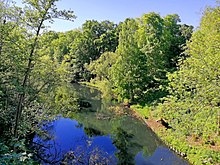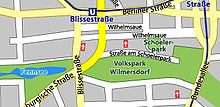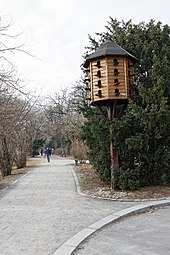Fennsee (Wilmersdorf)
| Fennsee | ||
|---|---|---|

|
||
| Fennsee in winter | ||
| Geographical location | Berlin-Wilmersdorf | |
| Data | ||
| Coordinates | 52 ° 29 '2 " N , 13 ° 18' 55" E | |
|
|
||
| surface | 2.1 ha | |
|
particularities |
Heavily eutrophied lake |
|
The Fennsee is a still water in the Berlin district of Charlottenburg-Wilmersdorf , near the Wilhelmsaue street , the former center of Alt- Wilmersdorf .
geography
The Himmelsteich with an area of around 21,000 m² is fed exclusively by groundwater inflows and precipitation. The water continues the side channel of the glacial channel of the Grunewaldsee chain to the east, which is interrupted between the Hubertussee and the Fennsee for around 2200 meters by the city motorway , through built-up area, various sports facilities and by the Wilmersdorf summer pool . The ice age side channel runs from the Schöneberg town hall to the west over the Wilmersdorf park to Lake Herthasee and meets the Grunewald channel at Koenigssee .
Location and history
The lake, with which Volkspark Wilmersdorf begins in the west, has an elongated, tube-like shape around 650 meters in length and around 35 meters in width and extends from the city motorway to the triangle Blisse- / Mecklenburgische / Uhlandstraße . In about half the range of Fennsee is from the bar street crossing or Barbrücke. In an easterly direction, it forms the last body of water of the side channel - as far as the Schöneberg Town Hall, only the depressions in the parks that have been created refer to the geological structure formed during the Ice Age. Until the early 20th century , the Wilmersdorfer See , popular with Berliners as a destination for excursions , was located between Mecklenburgische Strasse and Bundesallee , the “Seebad Wilmersdorf” with the famous “Tanzpalast Schramm”, which was filled in from 1915 and became part of the Volkspark was redesigned.
The Fennsee is surrounded by a path along the banks. The bank, which is quite steep in parts by Berlin standards, is laid out as a narrow parking strip in the southern area. On the north bank in the western part, right next to the footpath, follows the Wilmersdorf community cemetery from 1886 with many Berlin graves of honor ; The former farmer and later grand restaurateur Otto Schramm (1845–1902), the founder of the “Seebad”, is also buried here. In architectural terms, the impressed crematorium , masterminded the city architect Otto Herrenring as 1919-1922 classical domed building with adjacent columbarium was built.
Pollution
If the Halensee is already one of the most polluted Berlin waters, the Fennsee absorbs, according to the then Environment Councilor Martina Schmiedhofer, “the wastewater of three times the area [...]. […] Last but not least, the strong shading and the enormous mass of leaves that are brought into the lake every autumn by the dense stand have contributed to the poor water quality of the lake. [...] Every summer it is about to collapse and can only be used to a limited extent for recreational purposes due to the formation of hydrogen sulfide (smell). ”The residents put it more drastically:“ The lake stinks ”!
After the groundwater level in Berlin's glacial valley fell , the lake, which was originally fed with groundwater, no longer receives an adequate supply of fresh water. Because it is too far away, it is not connected to the pumping system of the Grunewald lake chain, which supplies these lakes with Havel water. There is no drainage for the supplied rainwater and street sewage. Nevertheless, the Fennsee traditionally serves as a receiving water for road drainage . In 2003, the Charlottenburg-Wilmersdorf district decided to take the following measures to improve water quality:
- Partial desludging of the Fennsee with sediment conditioning ,
- Establishing the connection via BWB canals to the Landwehr Canal to the drain ,
- Upgrading a coarse filter for cleaning the discharged road sewage,
- Restoration of the garden monument around the Fennsee,
- Reed planting .
In November 2003, the mandated district council , the district office , to clean up the Fennsees on the Senate funding from the UEP program of the EU to apply.
Current situation of the lake
The lake is currently stable in terms of its water quality, but is still one of the eutrophic Berlin lakes. Although the state of the water body has improved since the measures introduced in 2003, it is still occasionally polluted. Signs on the bank point out that it is forbidden to feed ducks. The background to this is that feeding wild animals leads to an increase in biomass , which sinks to the bottom of the water and affects the quality of the water. A stable ecosystem has developed in the immediate vicinity of the lake . The animal species richness also includes species that practice mimicry or mimeticism .
Web links
Individual evidence
- ↑ The Fennsee . At: berlin.de
- ↑ Decision BVV funding UEP program ( memo of September 27, 2007 in the Internet Archive )






